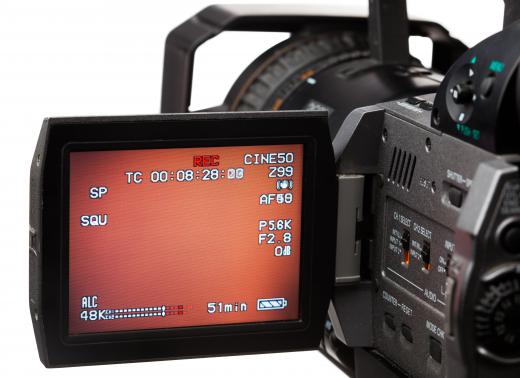At EasyTechJunkie, we're committed to delivering accurate, trustworthy information. Our expert-authored content is rigorously fact-checked and sourced from credible authorities. Discover how we uphold the highest standards in providing you with reliable knowledge.
Who Invented the Video Camera?
The complete history of the video camera is contained within only the last century or so, but as with many forms of modern technology, no one person is solely credited as having invented the video camera. John Baird, a Scottish engineer, was one of the earliest pioneers in capturing moving images for television production. His experiments were built upon others that had come before him, however, and much of the technology employed in the evolution of the video camera was built upon his findings. So while it's safe to say that Baird was a pioneer in video camera technology, it is not really fair to say that Baird was the video camera inventor.
The video camera as it is known today is able to record images and sound. The first demonstration of this capability took place on 14 April 1956. Ray Dolby, Charles Ginsberg, and Charles Anderson invented the first machine to record both images and sound. This invention sold for approximately $75,000 US Dollars (USD) apiece. Affordable only to major television broadcast studios such as CBS, who purchased three the same year, these machines remained professional devices for several years.

Video cameras designed for personal use, now called camcorders, became available to the general public in the 1980s. These machines were bulky, heavy, and expensive, but proved to be efficient. Building upon technology that had been developed for years, major electronics companies such as Sony and JVC began developing new technology. These companies invented the video camera as it is now known, and the devices were capable of capturing images, sound, and recording to a storage device all in one machine.

In the late 1980s and early 1990s, those same companies who had invented the camcorder began to miniaturize and digitize their machines. The device became smaller and more compact, and by the late 1990s, digital camcorders were the most popular form of video camera. Today, video camera technology is inserted into numerous portable devices including cell phones, PDAs, and digital cameras, capable of taking both still images and moving images as well as recording sound.
AS FEATURED ON:
AS FEATURED ON:













Discussion Comments
Was the video camera patented?
The forefather of today's modern camera, the device invented by John Baird, was that also used for filming cinema films?
@fitness234-- I have a photo camera that also has a video capability. I have tried using it to make home videos but the quality of the video and sound are not good.
So even though there are more and more devices that are video cameras and other things in one, they can't perform all these functions equally well. Most digital devices can still do only one thing well. The other functions are put there for consumers like you and me who think that we are getting more for our money. But that's not really the case.
Making good home videos still requires a proper video camera.
We still use tapes today Grassyknoll, even HDV!
@fitness234 - The rate at which video camera technology has developed is truly astounding. I remember taking a video class in 2004 where the cameras we used still had tapes in them! They shot fairly crisp images, but the transfer to digital (the media we were working with in post-production) was difficult, messy, and often times very frustrating. Just a few short years later though, we have handheld HD cameras for $200 that produce unbelievably sharp images. Six years ago, the thought that we'd be able to shoot high quality film that is easy to manage even for amateurs, seemed impossible.
Even though it has been less then a century since the development of the video camera, it amazes me how far the technology has come. I think the merging of still and motion cameras is not hitting the consumer market though and the lines between a still camera and a video camera art starting to blur.
For example, Nikon and Canon now have video capabilities in a large selection of their digital single lens reflex cameras. I personally would prefer only having to own a single device to capture both video and still images.
Post your comments